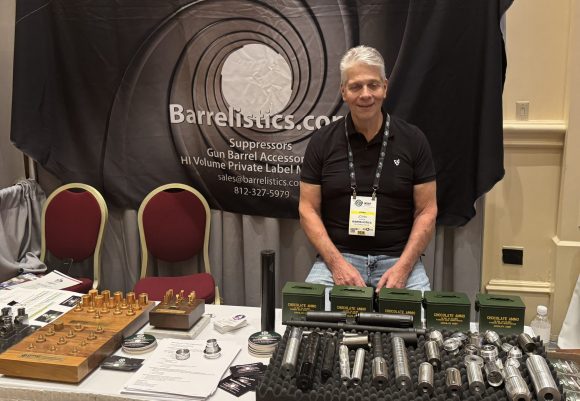Most shop owners get comfortable after 50 years. John Griner gets uncomfortable on purpose.
John has been making screw machine parts since 1979 while starting countless other businesses, which he refers to as “hobbies.” As a machinery dealer, I’ve bought and sold equipment from John over the years. He’s always a tough negotiator and always interested in trying new equipment and specking on opportunities that seem undervalued. And, he’s usually having fun with his business, which makes him fun to work with.
Today we’re exploring what it means to build a life around calculated risks, being most comfortable when you’re being uncomfortable, and keeping business fun.
Listen on your favorite podcast app using pod.link.
View the podcast at the bottom of this post or on our YouTube Channel
Facebook: https://www.facebook.com/swarfcast
Instagram: https://www.instagram.com/swarfcast/
LinkedIn: https://www.linkedin.com/company/todays-machining-world
Twitter: https://twitter.com/tmwswarfblog
*************
Link to Graff-Pinkert’s Acquisitions and Sales promotion!
*************
Interview Highlights
From Race Cars to Entrepreneurship
John’s journey into manufacturing began when he was frustrated he couldn’t find reliable parts suppliers for his racing hobby. “The people making my (race car) parts, they’d either charge me too much, they wouldn’t get them done on time or they’d mess them up,” he recalls. So he did what any determined gearhead would do: he started making his own parts.
What began as a solution to a personal problem became the foundation of Griner Engineering. After working as a tool and die maker for a semiconductor manufacturer and later an aircraft sheet metal fabricator, John’s boss gave him the news that would change everything: “Friday is going to be your last day working here. And I’m going to give you all the work that you possibly could want.”
John’s reaction? “That was the happiest day in my life. I literally went up my little space and broke into tears.”
When asked about his business philosophy, John admits he’s had to “have my head examined” for some of his decisions. But these weren’t reckless gambles—they were calculated risks that often paid off spectacularly. One of his biggest wins came in the early days when Ford threatened to cut prices in half and move work to Canada. Instead of accepting defeat, John bought his first Hydromat—a quarter-million-dollar investment that represented the entire value of his building at the time. “I didn’t think they’d succeed at it,” he says of the Canadian supplier. He was right. Not only did he keep the business, but Ford eventually became 70% of his revenue.
Another memorable gamble came when a $2 million company took on a $4 million automotive job, requiring three Hydromats and $3.5 million in equipment. “One year made a million dollars profit off of it,” John notes, proving that sometimes the biggest risks yield the biggest rewards.
The Art of Being Uncomfortable
What sets John apart from many business owners is his relationship with discomfort. While most people seek stability and predictability, John thrives on challenge and change. “I like to be uncomfortable. I’m bored. I get bored,” he explains. “I’m uncomfortable when I’m comfortable.”
This philosophy has kept him exploring new opportunities well into his 70s. His latest “hobby” involves 3D printing and manufacturing suppressors—a venture that combines his love of learning new processes with his knack for finding undervalued opportunities.
John’s approach to new ventures is telling—he calls them “hobbies” rather than businesses. But don’t let the casual terminology fool you. “All my hobbies always have turned into businesses,” he explains. “Anything I do, I try to turn into a business.” From exotic animals (his first wife’s clowning business complete with monkeys and an alligator in the bathtub) to software development, from a failed Mexico plant to his current 3D printing venture, John has never been afraid to explore new territories.
Throughout our conversation, John repeatedly emphasized the importance of enjoying what you do. “I think just enjoy what you’re doing. I personally myself, I like new opportunities, learning new things,” he says. His approach to business challenges is refreshingly pragmatic. When I asked about his tolerance for difficult employees, he admitted, “I don’t really demand respect out of people. If they can kind of figure it out… long as we get the job done, I’m not saying that’s the right way, but that’s just how I tend to do things.”
Taking Calculated Risks
When asked about the role of luck in his success, John points to several “last-minute saves” that kept his business afloat during tough times. In 2004, when material prices doubled and customers refused to pay, he sold his Mexico plant at the perfect moment, getting back the cash he needed to weather the storm. “I’ve had money fall in my lap a lot of times,” he admits with characteristic humility.
For aspiring entrepreneurs, John’s advice is simple: “Find somebody with the money. Follow the money.” Rather than buying equipment first and hoping for work, he suggests finding customers who need work done, then building the capability to serve them. He also believes service industries might offer better opportunities than manufacturing for new entrepreneurs, citing higher hourly rates and lower capital requirements.
At 71, John Griner continues to challenge himself with new ventures, new technologies, and new markets. His secret isn’t avoiding discomfort—it’s embracing it. In a world where most business owners his age are thinking about retirement, John is learning 3D printing and exploring new markets.
“I need some challenge,” he says. “I like to keep playing the game.”
For John Griner, the game is never over. That’s exactly how he likes it.
Question: What’s the biggest risk you’ve taken in your business? How did it turn out?
Podcast: Play in new window | Download




1 Comment
Amazing podcast